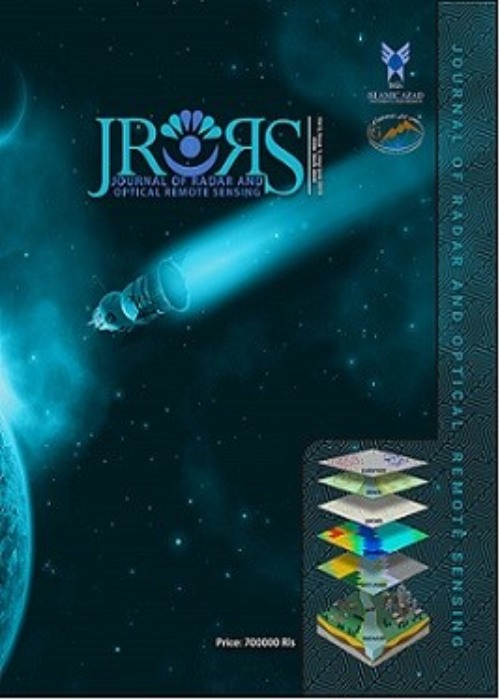فهرست مطالب

Journal of Radar and Optical Remote Sensing
Volume:6 Issue: 2, Spring 2023
- تاریخ انتشار: 1402/11/17
- تعداد عناوین: 4
-
Optimum pattern to identify flooded areas using remote sensing techniques (Houiza)Page 1
Several methods have been developed to represent flood-related hazards using ground-based measurements. Satellite remote sensing data have been used for flood assessment due to their spatial resolution and capacity to provide information for areas with poor access or lack of ground measurements. Identifying flood prone areas is one of the basic strategies in planning to reduce the destructive effects of floods. Flood is considered as one of the events that causes damage to human societies. Therefore, the importance of estimating the damages caused by flood and determining its extent in planning to reduce these damages and determining high risk points is very important. For this purpose, the OLI sensor images of Landest 8 satellite, before and after the flood of April 2018 in Khuzestan, Hoyze region, were used. Then NDWI water index was used for identification and SVM (Support Vector Machine) method was used for classification and it was found that before the flood there were 36999.99 hectares of water areas in the region and after the flood this amount reached 274279.95 hectares. The results show that the south and south-west parts are in a very severe situation and the central and south-eastern parts are in a severe flood risk situation, which are among the most prone to flood areas in the province. Also, the monitoring of flood maps in Khuzestan province shows that there is a perfect match between the flood zone map and the recent flood.
Keywords: Flood, Landsat, remote sensing, Hoyze, backup vector machine -
The use of Aster satellite images and SVM technique in zoning and prioritizing worn-out urban fabric against earthquakes (Case example of Region 3 of Kerman city)Page 2
Earthquake is one of the basic natural calamities of today's era, which always happens in a very short period of time and sometimes has irreparable results. Today, the vulnerability of cities and especially old and worn-out structures to earthquakes is a global issue facing experts in various fields. This situation has been manifested in a more serious way in countries with risky natural structures, including Iran, during the past decades. As a result, although it is not possible to prevent an earthquake, it is possible to reduce the damage caused by it. The experience of earthquakes in recent decades has shown that a major part of the damages caused by earthquakes can be due to the lack of proper knowledge of vulnerable points, in fact, for proper knowledge and evaluation, study and sufficient background of information is required. And reliable knowledge is required. Since the city of Kerman is located in the tectonic zone of central Iran and has large and deep faults and fractures from the geological point of view, as well as the existence of unsuitable materials for buildings and houses, dilapidated residential units, high age Buildings, inappropriate accesses and winding passages in the areas of worn-out fabric can be the source of huge crises, severe damages and casualties, therefore, due to the vulnerability of the city and especially the worn-out fabric against earthquakes, in this research First, by using the ASTER satellite images of 2007, the worn-out textures of Kerman city were identified
Keywords: Earthquake, Vulnerability, Worn Texture, remote sensing, Vector Machine Classification -
Pages 7-18
In recent decades, rapid and incorrect changes in land use have been associated withconsequences such as natural resources degradation and environmental pollution.Detecting land use changes is a suitable technique for natural resource management.The goal of this research is to study the land use change in Haraz Basin with an area of677000 hectares in 15 years (1996 & 2011) using Landsat data. After making thenecessary corrections and preparing the indices, the image classification into nineclasses was by supervised classification and Maximum Likelihood algorithm. Finally,the changes were extracted by Post classification comparison. The results showed thatduring the 15 years there was a 27.5% change in land use of the area. These changesare related to conversion of rangelands to bare lands and dry farming ones; and alsoconverting the dense forest to sparse forest, horticulture, farming lands, and residentialareas. These changes can be due to an increase in population and human activities,which result in increasing demands for natural sources and converting them intofarming lands, horticulture, residential and industrial areas. These land use changesalong with climate changes are an alarm for the Haraz Basin status in the future.
Keywords: land use, Change detection, Haraz Basin, remote sensing -
Pages 19-30
Solid waste production has been a major problem in human societies in recent decades. Changes in consumption patterns have imposed great problems and costs on large cities to dispose the waste. Today, the geographic information system is considered due to the possibility of analyzing a huge volume of information layers, which has been used in this study to investigate the current stations and improve them. National and international experiences, three layers of the population, land use and access route have been selected. The hierarchical analysis method has been used to weigh the criteria and Landsat images of Shiraz have been used to locate the stations. According to experts, the covered population with the weight of 0.540 has the highest value, land use with 0.297has the next priority and access route with 0.163 is used to improve the collection stations for home recycling materials in Shiraz, based on the population in 1396. Assuming that 50% of the city's population delivered their recycled materials to the stations, 61 stations were located using Landsat images, of which 16 stations with a short distance (300 meters) from the current station were shown. Twenty-one medium-distance stations (300-700 meters) and 24 long-distance stations (more than 700 meters) were identified. In areas with long-distance stations, it is necessary to build and add drop-off centers, collecting recycled materials
Keywords: Landsat, Shiraz, Geographic Information System, Recycling, hierarchical analysis, drop-off centers

